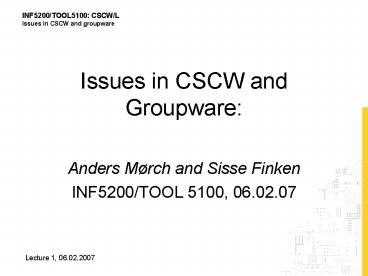Issues in CSCW and Groupware: - PowerPoint PPT Presentation
1 / 20
Title: Issues in CSCW and Groupware:
1
Issues in CSCW and Groupware
- Anders Mørch and Sisse Finken
- INF5200/TOOL 5100, 06.02.07
2
Outline
- What is CSCW and groupware and their relation to
CSCL - Historical development
- Basic problems addressed
- Research areas and concepts
- Components of groupware
3
What is CSCW?
- CSCW Computer Supported Cooperative Work
- Introduced by Irene Greif and Paul Cashman in
1984, meaning - A set of concerns about supporting multiple
individuals working together with computer
systems - Can be divided into two main areas, associated
with 1) CS and 2) CW, respectively
4
Illustrating the situation
- HCI is one of the precursors to CSCW and was
concerned about supporting the work of
individuals using a computer system
CSCW
HCI (Human Computer Interaction)
5
Relationship between HCI, CSCW and CSCL and other
influences
6
What is groupware?
- Associated with the CS part of CSCW
- Groupware was first used in 1982 in a paper by
Johnson-Lentz in the context of computer-mediated
communicating (CMC) systems - Defined by Ellis et al. in following way
computer-based systems that support groups of
people engaged in a common task (or goal) and
that provide an interface to a shared
environment - This creates a need for concepts to describe the
various aspects of groupware
7
Aspects of groupware
- Common task / goal
- Interface to a shared environment
- In addition, because there are more than two
users, additional implications are - Division of labor, explicit role assignment
- Awareness of the other users who are interacting
within the shared environment (since they are
often not F2F)
8
Shared environments
- Referred to as common information spaces
(Bannon Bødker, 1997) - At least three ways to design them
- Extending a single user environment to a multi
user environment (technology approach) - Identifying a collaborative situation that is
currently unsupported by technology
(empirical-based approach) - Basing the design on theories, models or design
principles representing general (communication)
activities or application domains (theory based
approach)
9
Examples for discussion
- Do you know of groupware or other systems that
have been developed according to the above
approaches - What other approaches to design do you now of,
which are not falling into the three categories
just described?
10
Early examples of groupware
- Ellis et al identifies the following type of
groupware (1991) - Message systems (e.g. email)
- Multi-user editors
- Group decision support systems (e.g. discussion
forums) - Video conferencing systems
- Intelligent information sharing systems (Malone
et al.) - Workflow coordination systems (Winograd et al.)
11
What is group work?
- Related to the CW part of CSCW
- Jonathan Grudin suggests the following
- Small group usually consisting of 2-3 people who
works together to reach a common goal - There are also larger groups, but they are less
efficient when supported by technology - Why do you think groupware works best in small
groups? - Any counter examples you know of?
12
Historical development (Grudin, 1994)
13
Basic concepts in CSCW
- Ellis et al. identify the following three terms
are basic for CSCW research and design - Communication
- Coordination
- Collaboration (sometimes divided into 2)
- Cooperation
- Collaboration
14
Supporting communication
- Groupware falls into two categories depending on
the type of interaction it supports - Synchronous communication (real time)
- Asynchronous communication (indirect)
15
Synchronous communcation
- Advantages
- Good support for awareness of others (modeling
F2F) - Appropriate for many kinds of situations
resembling F2F - Disadvantages
- Complexity of developing from scratch technology
to support this form of communcation can
outweigh its advantages - Work that require high amount of individual
concentration (i.e. time consuming individual
work) is not well supported (e.g. collaborative
writing a paper)
16
Asynchronous communcation
- Advantages
- Allows time for individual reflection before
making a next move while interacting (over time)
with others - Good for tasks that naturally lend themselves to
clear division of labor - Disadvantages
- Social interaction is minimal (in its F2F form)
- Motivation to work together over an extend period
of time may be lower and requiring incentives to
work
17
Modelling F2F vs. going beyond being there
- In recent years some researches have questioned
the prevailing F2F metaphor of CSCW - They instead ask how can we extend beyond being
there - Identify new metaphors for communication, and
cooperation that leverages the strengths of the
new medium og groupware (e.g. Jim Hollan)
18
Time/place matrix
From Ellis et al, 1991
19
Extended matrix for CSCL
- One of the approaches to CSCL we address in this
course is to use groupware for educational
purposes - What additional dimensions would be necessary or
recommended to add to the time/place matrix in
order to be able to better account for the
factors that emerge in educational contexts (e.g.
classrooms, work learning) ?
20
Extended matrix for CSCW
From Grudin, 1994









![[CSCW] Computer Supported Cooperative Work PowerPoint PPT Presentation](https://s3.amazonaws.com/images.powershow.com/7918627.th0.jpg?_=20160622076)



![[CSCW]%20Computer%20Supported%20Cooperative%20Work PowerPoint PPT Presentation](https://s3.amazonaws.com/images.powershow.com/P1246990950qhMPp.th0.jpg?_=20180511068)

















